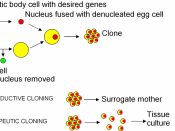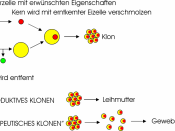Conservation CloningScientists know that the ability to resurrect an entire species lies right in front of them. But the question is: will cloning be used in conserving wildlife? This question has sparked arguments between the science and conservation groups throughout the entire world. There are moral values supporting both sides of the argument, as well as thoughtful reasoning as to why cloning should and shouldnÃÂt be used to conserve endangered species. Cloning endangered species could prove to be a viable way of saving nature, but could also be a way of destroying it. There are many pros and cons of cloning animals which will be discussed, as well as opinions of conservationists, scientists, and the author. But first, so the technology is understood while reading, general information about cloning will be discussed.
Reproductive cloning is a technology used to create an animal that has the same genetic make-up as another living or non-living animal.
Dolly, a sheep, the first successful clone of a mammal, was created by reproductive cloning knowledge. In a procedure called "somatic cell nuclear transfer" (SCNT), scientists relocate genetic matter from the nucleus of a mature donor cell to an egg whose nucleus and genetic material has been removed. The reconstructed egg containing the DNA from a donor cell must be treated with chemicals or an electric current in order to kindle cell division. Once the cloned embryo reaches an appropriate phase, it is moved to the uterus of a female host where it continues to grow until birth. Also, mutations take place with every cell division so no two cells in a being are the same, meaning that the clones are different from the donor, as well as other clones. Thus, SCNT clones from different maternal lineages are not clones in a sense because...


